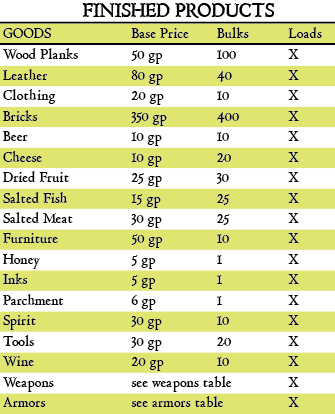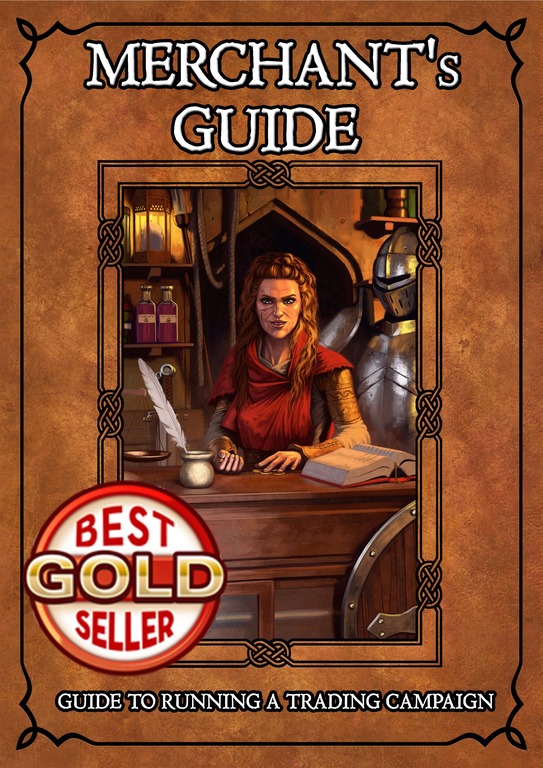TRADE GOODS SUMMARY
Previous article…D&D – Merchant #4 – Trade Goods – Raw Materials
This is going to be an article of transition to summarize into a table all the trade goods previously mentioned.
Base value, Price Fluctuations and Encumbrance will be detailed later, in the followings articles, where we will employ this summary to fill it with the missing informations.
We also want to introduce an optional rule.
The optional rule will describe the possibility to gather/hunt/capture some of the trade goods.
We’ll do this because we assume that the merchant may encounter creatures and other things that can have a commercial value, provided they are properly treated.
We have published the awesome Merchant Guide, a pdf available on DrivethruRpg. Just have a look at the preview to have an idea of the content.
Also, if you already have an idea on how to run your own trading campaign you may want to have a look at our Trade Goods Generator.

(*) these goods come with the optional rule to obtain them beyond the normal buy and sell procedure.


note: all the tables contain the goods, the base value and the encumbrance, however they may be expanded to display additional informations.
OPTIONAL RULE – SKILLS & HIRELINGS
or Gathering, hunting, capturing, crafting, etc…
We have to include the possibility that a merchant, being a character that travel across the the known and uknown world, stumbles across things that may be valuable.
This implies including an extensive list of skills and hirelings that are experts in their area of expertise.
Example
The merchant encounters a wild herd of strange animals, he assumes that this weird creatures may be employed as livestock, or they produce an exotic form of honey, or a milk with a strange and unknown flavor. In such a case, taming the animals will be essential before even thinking about capturing them.
So, if the merchant doesn’t possess the Handle Animals skill, he’d better have employed an expert to do the job.
Technically any of the goods mentioned in the tables can be gathered, hunted, captured, crafted and so on.
So, every entry requires an enhanced description.
In this article however, we will provide an enhanced description of some of these goods, not all of them.
The entry that follow will employ something called size multiplier.
The size multiplier works as follows:
tiny 1/4, small 1/2, medium 1, large 2, huge 4, colossal 8, gargantuan 16
RARE FURS
Rare furs base value depends on the creature Hit Dice and Size
If the creature is not of the animal type, then it can yield rare fur.
As a general rule a creature yields 10gp/HD multiplied by its size multiplier.
Skill: Furrier
Hireling: Fur maker
Example 1 – Chimera
A merchant and her hirelings encounters and defeat a chimera. The chimera is a large monstrosity (D&D 5ed.) with twelve hit dices. So, the base value of its rare furs is 10gp * 12HD * 2 size = 240gp.
However the Game Master may state that not all the skin of the chimera yields fur, the dragon and the goat reduce that amount. So, the Game Master decides to reduce by 20% the yield in rare fur, 10% due to the dragon head and 10% due to the goat head.
The rare fur base value is not 192gp. However the 10% related to the dragon head yields rare leather, which is more valuable than rare fur, while the remaining 10% related to the goat is just worthless (unless the party wants to employ the goat to make a tasty barbacoa).
Example 2 – Displacer Beast
The merchant manage to ambush and kill a displacer beast. The displacer beast is a large monstrosity (D&D 5ed.) with ten hit dices. So, the base value of its rare fur is 10gp * 10HD * 2 size = 200gp.
However the Game Master may state that the displacer beast peculiar abilities increase the base value of its fur.
The fur of the displacer beast is now worth 20gp/HD, thus increasing the base value to 400gp.
Example 3 – Aurumvorax
The merchant hunt and kill a ferocious aurumvorax (AD&D 2ed.).
The aurumvorax may belong to the animal type or magical beast type (Pathfinder), depending on the RPG you want to refer to.
The aurumvorax is a small creature with twelve hit dice. So, the base value of its rare fur is 10gp * 12HD * ½ size = 60gp.
If in your campaign the aurumvorax belongs to the animal type, you may state that it can yield rare fur despite that.
RARE WOODS
Rare woods value depends on creature hid dice and size. The creature must belong to the plant type.
As a general rule a monster yields abase value of rare wood equal to 20gp/HD multiplied by its size multiplier.
Skill: wood cutting
Hireling: wood cutter
Example 1 – Treant
The treant is a huge plant with twelve hid dices. So, the base value of its rare wood is 20gp * 12HD * 4 size = 960gp.
Example 2 – Dryad
The dryad is a medium fey (D&D 5ed.) with five hit dices. So, the base value of its rare wood is 20gp * 5HD * 1 size = 100gp.
The Game Master may state that, even if the dryad is a fey, once killed it may yields wood due to its strong connection with plant life.
EXOTIC CREATURE
An exotic creature is such if its frequency is rare, very rare or almost unique. AD&D 2ed. Introduced creatures’ frequency, subsequent edition did not.
As a general rule you may consider a creature as “exotic” if it doesn’t belong to the humanoid or animal type.
However some creature type are more valuable than others.
Capturing and selling an outsider yields much more than an aberration for example.
We will employ the Pathfinder creature type list because it’s more complete. Adapting this list to other D20 systems, like 5th edition, is pretty easy.
Needless to say, an exotic creature must be alive in order to be sold at its full value. It’s up to the merchant and his team to keep the creature alive…or don’t get killed.
Aberrations: 30gp/HD*
Constructs: 60gp/HD*
Dragons: 80gp/HD*
Fey: 50gp/HD*
Magical Beast: 40gp/HD*
Oozes: 10gp/HD*
Outsiders: 70gp/HD*
Undead: 20gp/HD*
Double the base value for every special ability the creature possesses
Skill & Hireling: capturing creatures usually requires mixed skills, the merchant should hire NPCs with class and levels or team with other PCs.
Example 1 – Grick (aberration) – D&D 5ed. monster manual
The merchant and his fellow ranger, specialized in hunting aberrations, know where a lair of gricks is located. Aided by some hirelings the manage to capture one.
The grick is a medium aberration with six hit dices, so its base value is 30gp * 6HD * 1 size = 180gp. However the grick possesses a special ability, stone camouflage, that increases the base value per hit dice by 30gp, so the base value of a grick is now 60gp * 6HD * 1 size = 360gp.
Example 2 – Grick (aberration) – Pathfinder bestiary
The grick from Pathfinder is a bit different, but not too much.
Pathfinder’s grick is medium aberration with five hit dices, and the creature’s entry doesn’t describe the stone camouflage as a special ability, it is just a bonus to stealth skill. So, this grick base value is 30gp * 5HD * 1 size = 150gp, no special ability, no increased value.
RARE LEATHERS
Rare leathers are employed to craft special armors. By employing these leathers a skilled artisan can craft leather armors as strong as metal armors, depending on how sturdy the creature’s skin is .
As a general rule a rare leather is worth 20gp/HD multiplied by its size multiplier.
A leather armor made of rare leather grant an armor class equal to the (creature AC)-10 –(Dex bonus)-1.
A large creature provide enough leather to craft a medium armor, or two small armors.
A huge creature provide enough leather to craft two medium armors, or four small armors, and so on.
Skill: tanning
Hirelings: tanner
Example 1 – Gorgon
The gorgon is a large creature (D&D 5ed.). Its leather is worth 20gp * 12HD * 2 size = 480gp. Being a large creature, you can craft a medium armor or two small armors.
A gorgon’s AC is 19 and its Dex bonus is zero, so you can craft an armor that grants 19-10-0-1=8 points of armor class.
CONCLUSIONS
We can include other type of goods and provide details on how to gather, hunt or capture such goods.
We will extend the list later, what matters now is that the general idea about how this work is clear.
Next Article… D&D Merchant #6 – Base Prices
